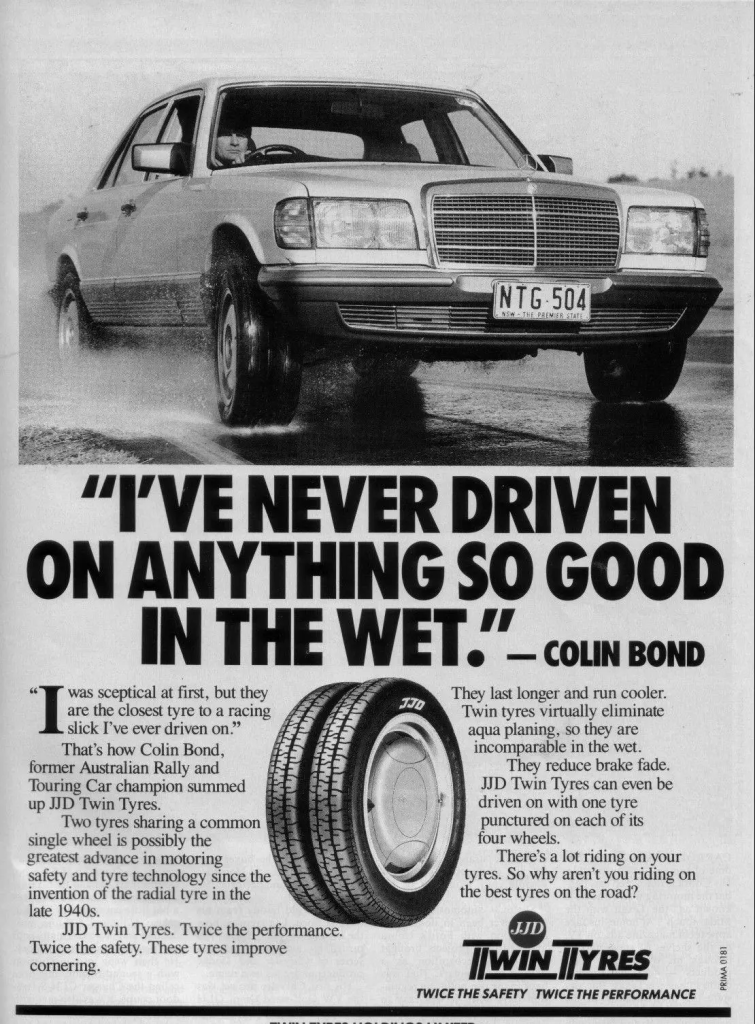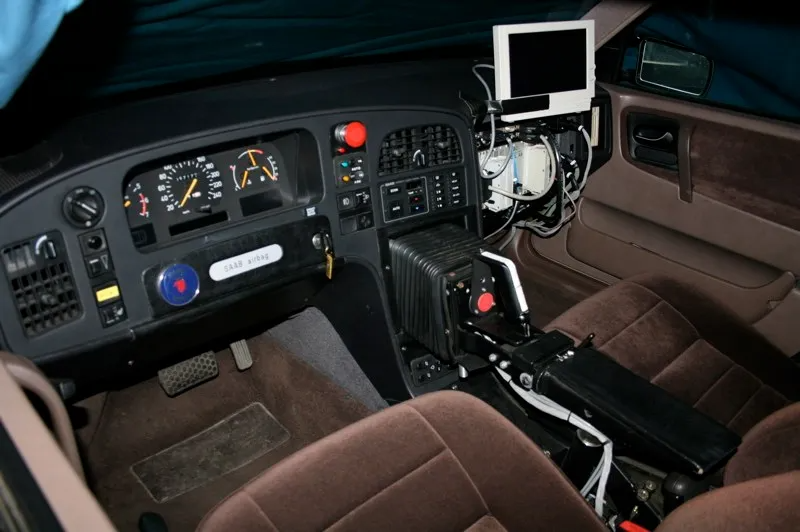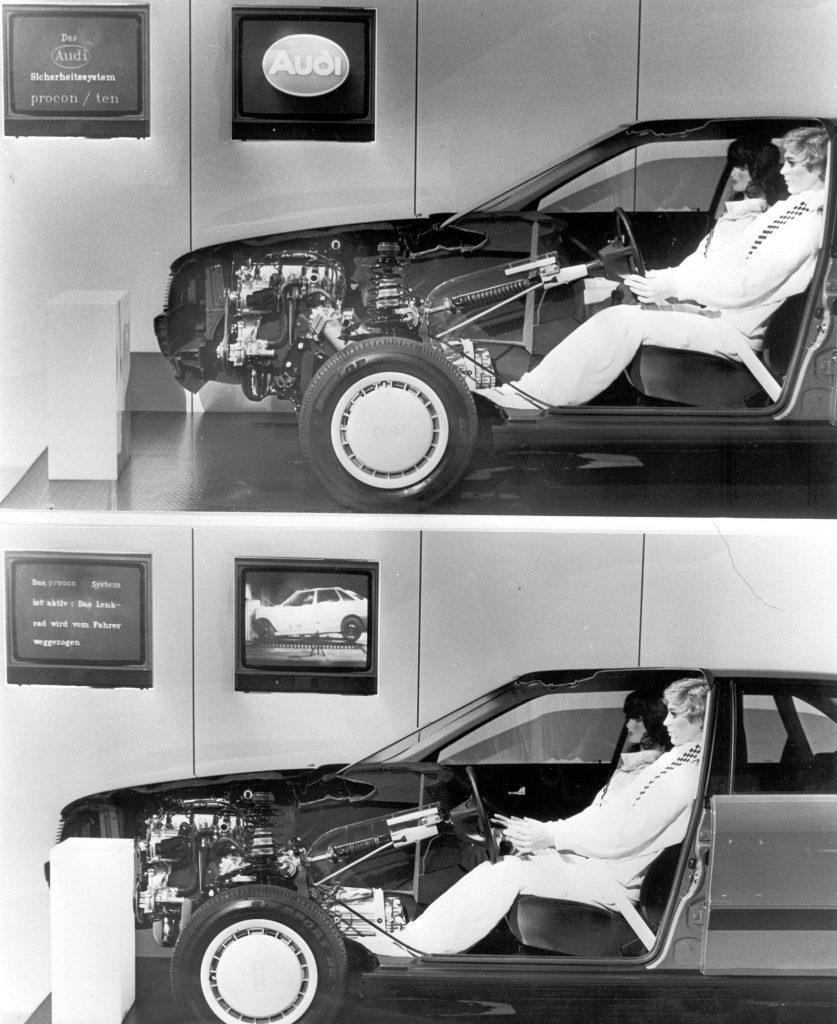Under Britain’s Red Flag Act of 1865, the burgeoning motor carriage was restricted to just two miles per hour in towns and four miles per hour on country roads. What’s more, it was required that every vehicle always had three people with it: one to drive, one to ride shotgun, and a third to walk in front carrying a red flag.
For 30 years, until the act was repealed, this was how car safety was enforced. But if you think that idea was daft, just wait until you see what else automotive inventors came up with.

The Safety Scoop
In 1939, two boffins in Sheffield devised the Safety Scoop. Fitted to, or replacing, a car’s front bumper, the spring-loaded device would deploy a large fabric catcher to scoop up any pedestrians who weren’t paying attention.
“When the scoop is open a jaywalker simply can’t get run over—and sometimes that’s more than he deserves,” reported British Pathé. This wasn’t even the first time such a concept had been tried—with a similar setup demonstrated in Germany in 1927. Unsurprisingly, neither version took off.
The Overtaking Aid
Passing a slower-moving car on a single-lane road has always been a potentially risky business. Is the road ahead clear and straight enough? Has the driver ahead noticed you? Is he or she about to turn off or stop? In 1936, in a bid to make overtaking safer, a British inventor came up with a roof-mounted sign so that the driver could indicate to the car behind whether it was safe to pass. However, the idea of taking said responsibility away from the overtaking driver was bonkers, not to mention it simultaneously gave the slower driver authority. Seems to be the perfect road rage recipe.
The Crab Car
Designed to diminish the danger of parking scrapes, the 1938 Crab Car, demonstrated in London, deployed a set of mounted trolley wheels so that the car could be driven sideways into a parking space. Apparently the idea was considered by Britain’s War Office, although perhaps the actual war got in the way of it being adopted. Today, the concept is back with tank-turning EVs such as the Hummer and Hyundai’s amazing axle-articulation. So maybe it was just ahead of its time.
The Tyre Trolley
No time to fix a pesky puncture? Then a tyre trolley shown in London in 1960 might just be the answer. The device, like the go-jacks used to move cars around shows or workshops, slid under the wheel and tyre, allowing the driver to proceed. With what are, essentially, shopping cart casters now replacing one corner of your car, it must have been quite a handful at anything above a walking pace.

The Twin Tyre
On the subject of tyres, there have been many attempts to reinvent the rubber around things. Truck drivers have long been used to driving with two pairs of wheels and tires on a rear axle, but in the 1980s, Porsche factory racing driver Jaroslav “Jerry” Juhan came up with the concept of having twin tyres on a single wheel. The idea was that, in the rain, the channel between the two, narrower, tyres would clear water better, while in the dry the contact patch wouldn’t be compromised. JJD Twin Tyres was the result, and Juhan even managed to get several wheel manufacturers – including ATS, Crimson, and Speedline – to sell compatible wheels, while the tyres were available from Avon and Toyo. Despite its benefits, the additional cost and weight of the Twin Tyre setup meant it never made it to the mainstream.

The Joystick Car
If you think Tesla’s yoke is a joke, then what would you make of Saab’s attempt to do away with a steering wheel completely? In the early 1990s, the Swedish firm developed a version of its 9000 with a joystick mounted in the center console. Why? To remove the risk of the driver hitting the steering wheel in an accident. While sound in principle, the problem was that the setup was ridiculously difficult to drive. The stick operation was simple: twist left to go left and right to go right; but with 180 degrees of total movement, steering was super twitchy. The idea was abandoned. On the plus side, some other features of Saab’s “Prometheus” project, such as adaptive cruise control and infra red cameras, would become widely adopted safety features.

Procon Ten
Audi’s Procon Ten system was undoubtedly ingenious, but the arrival of airbags rapidly rendered it obsolete. Procon Ten, released in 1986, used a network of steel cables running around the rear of the engine and connected to the steering column and seat belt mounts. In the event of a frontal collision, as the engine was shunted backwards, the cables pulled the steering wheel away from the driver while the seatbelts were simultaneously tightened. Fitted to the Audi 100/200 and 80/90, it was axed by the time the A4, A8, and A6 arrived to replace them.










The ‘pedestrian catcher’ reminded me of an incident in Blackpool where a work colleague was crossing the tram tracks to go bait digging on the beach. He stopped and bent down to light his tilley lamp, and there was a tram coming which hit him. He was saved from really serious injury by a ‘dog catcher’ device at the front of the tram which has a cage underneath with a retractable door at the front. He made the front page of the local paper with the headline “Lucky to be Alive” !
Twin tyres seem good idea, except for the increase in unsprung weight, complexity of installation, pressure checks and cost. Given modern car companys’ love of complexity and electronic gizmos (double the number of pressure sensors to go wrong frequently), plus the weight of EVs, I’m surprised they are not back on the agenda!
In the 70s we reinvented the Crab Car concept by four of us – one at each corner – bouncing a Mini into parking spaces that were just big enough to take the car. Don’t imagine the folk either side were impressed when they wanted to leave!
For years many cars had solid emblems mounted on the bonnet (e.g., Rolls Royce silver lady, Leaping Jaguar on a Jaguar, etc. Great for spearing the unwary pedestrian.
The car with the ‘Safety Scoop’ looks very much like a 1935 Morris 12/4, a car made for under 1 year. My late father had one between 1936 and 1960
Great interesting article. Thanks.
When ‘new fangled’ disc bakes started to become more mainstream on high-end cars in the 1950’s, manufacturers such as Jaguar placed a small warning sign on the rear bumper to warn following traffic that braking performance would be that much better than previously known. And I expect it was as much about promoting the new braking system, as much as giving out any kind of warning to other drivers, and the irony was that you had to be dangerously close to be able to read the sign in the first place!
Two miles per hour in towns !! Don’t tell the bloody council or they’ll bring it back.